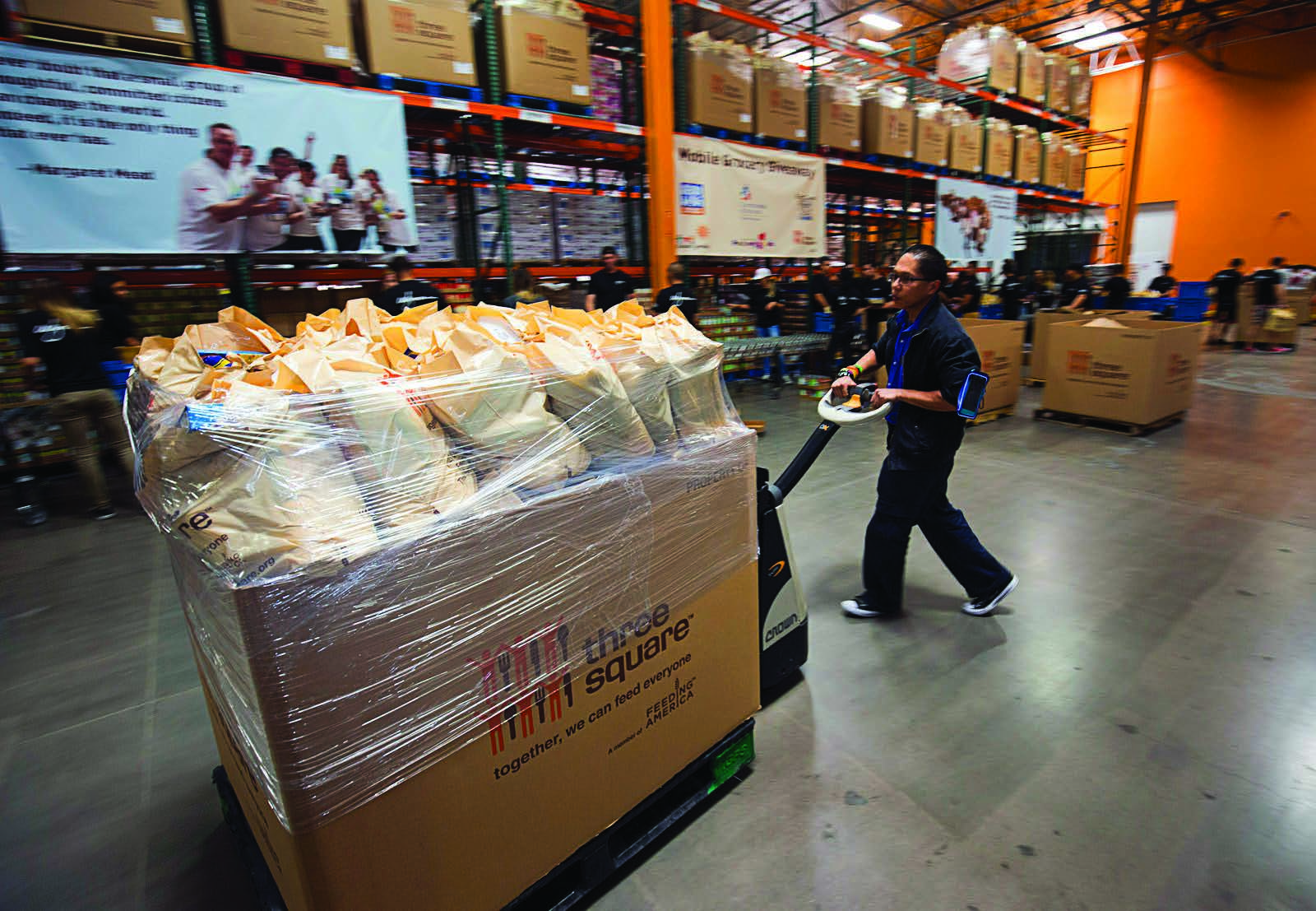
A worker moves bags a of meals assembled for mobile food pantries in 2016 at Three Square food bank’s north campus, 4220 N. Pecos Road. Feeding America’s annual “Map the Meal Gap” report shows a slight uptick with 16% of people in Southern Nevada dealing with food insecurity issues.
Editor’s note: Este artículo está traducido al español en la página 8.
Nearly 1 in 6 Southern Nevadans is struggling to put food on the table, according to a newly released national report.
Feeding America’s annual “Map the Meal Gap” report shows a slight uptick in Southern Nevada from last year’s study, moving from 14.7% to 16% of the region dealing with food insecurity.
Feeding America is a nationwide network that includes food banks, food pantries and local meal programs, and touts itself as the leading voice on ending hunger in America.
The increase wasn’t a surprise to Beth Martino, president of local food bank and Feeding America member Three Square.
“We have been hearing that from the food pantries and food programs that we work with,” Martino said. “More people are coming to food pantries, to food distributions, to food programs looking for help.”
Food-insecure locals in Southern Nevada are missing an average of 6.3 meals a week and collectively skip 72 million meals a year, according to the study. And while most live in Clark County, it found that Nye and Esmeralda counties both had higher hunger rates: 18.3% and 21.9%, respectively.
Food insecurity is also slightly more common among the region’s children, over a fifth of whom live in “food-insecure households.”
Martino said the new data would help Three Square develop a strategy about how to best deliver food, but that it also reinforced the supply and demand issues currently facing Three Square.
“We have more people in need, but we have less food coming in,” she said. “Even right now, we’re having trouble putting food on the shelves because we are sending out more food than we are able to bring in.”
Martino last month said the organization was monitoring potential cuts to programs under the Republican-led federal budget process, worrying that slashes to the Supplemental Nutrition Assistance Program or Medicaid would mean more people going to Three Square.
Last week, the organization got a better sense of what that might look like. The Republican majority on the House Agriculture Committee approved a $300 billion cut to food aid Wednesday that would require states to chip into the SNAP program depending on each state’s payment error rate.
With Nevada having a 6.7% error rate in the 2023 fiscal year, the state would pay 15% of the cost of SNAP benefits starting in 2028 under the House committee’s plan. The Center on Budget and Policy Priorities found that Nevadans on SNAP received $1 billion in benefits last year.
The plan comes as Nevada faces a budget crunch. On May 1, the Nevada Economic Forum projected state revenues over the coming two years would be $191 million lower than the prediction the group made at the end of last year, limiting what the state Legislature can accomplish this session.
Speaking to lawmakers this month, Martino said each had the same message for her:
“There isn’t extra money to go around for much of anything,” she said.
“To shift any cost to states, let alone a cost of this magnitude, really means that fewer people will be eligible for those programs,” Martino said. “I think most states would have no choice but to make changes to eligibility.”
Even those who are outside of SNAP’s income range are feeling the ongoing effects of inflation, which Martino says is a large reason for the growth of food insecurity over the past few years in Southern Nevada.
Martino said she met a woman at a food distribution site a few weeks ago. The woman still had on her work uniform when she arrived. She’s working full time and at night, but still is not earning enough to feed her family, Martino said.
People “need more help than they did a few years ago. So it’s both more people and it’s the same people who need more help,” Martino said. “The bottom line is that food insecurity is a growing problem.”
kyle.chouinard@gmgvegas. com / 702-990-8923 / @Kyle_ Chouinard

